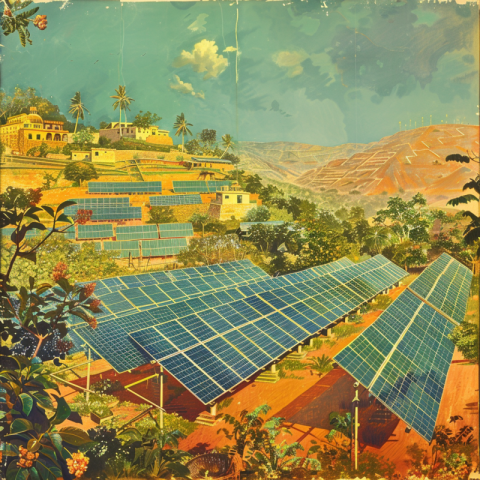











Powering a Sustainable Future - Harnessing Nature's Power
Renewable energy, derived from natural processes that are replenished over relatively short periods, is playing an increasingly vital role in meeting the world's growing energy demands while mitigating the impacts of climate change. Unlike fossil fuels, which are finite resources and major contributors to greenhouse gas emissions, renewable energy sources offer a cleaner, more sustainable alternative for generating electricity, heating and cooling buildings, and powering transportation. The shift towards renewable energy is driven by environmental concerns, technological advancements, and decreasing costs, making it a key component of a sustainable energy future.
1. Sources of Renewable Energy: Harnessing Nature's Power
Renewable energy comes from a variety of naturally replenished sources:
- Solar Energy: Harnessing the sun's radiation to generate electricity or heat.
- Photovoltaic (PV) Systems: Convert sunlight directly into electricity using solar panels.
- Solar Thermal Systems: Use sunlight to heat water or air for domestic or industrial use.
- Concentrated Solar Power (CSP): Uses mirrors to focus sunlight and produce heat which can then be turned into electricity.
- Wind Energy: Using wind turbines to convert the kinetic energy of wind into electricity.
- Onshore Wind Farms: Wind turbines located on land.
- Offshore Wind Farms: Wind turbines located in bodies of water, typically oceans or large lakes.
- Hydropower: Generating electricity from the flow of water.
- Dams: Large dams create reservoirs that store water, which is then released through turbines to generate electricity.
- Run-of-River: Uses the natural flow of a river to generate electricity, without the need for a large dam or reservoir.
- Tidal and Wave Power: Using the movement of tides and waves to generate electricity.
- Geothermal Energy: Utilizing heat from the Earth's interior for electricity generation or direct heating.
- Geothermal Power Plants: Use steam or hot water from underground reservoirs to drive turbines and generate electricity.
- Geothermal Heat Pumps: Use the constant temperature of the earth to heat and cool buildings.
- Biomass Energy: Generating energy from organic matter, such as wood, crops, and agricultural residues.
- Biofuels: Liquid fuels, such as ethanol and biodiesel, produced from biomass.
- Biogas: A mixture of gases, primarily methane, produced from the anaerobic digestion of organic matter.
- Biopower: Burning biomass directly to generate heat or electricity.
2. Benefits of Renewable Energy: Environmental, Economic, and Social Advantages
Renewable energy offers numerous advantages over fossil fuels:
- Environmental Benefits:
- Reduced Greenhouse Gas Emissions: Renewable energy sources produce little or no greenhouse gas emissions, helping to mitigate climate change.
- Improved Air Quality: Replacing fossil fuels with renewable energy can reduce air pollution, improving public health.
- Reduced Water Consumption: Many renewable energy technologies, such as solar PV and wind, use significantly less water than fossil fuel power plants.
- Economic Benefits:
- Job Creation: The renewable energy sector is a growing source of jobs in manufacturing, installation, maintenance, and research.
- Energy Independence: Renewable energy can reduce reliance on imported fossil fuels, enhancing energy security.
- Cost Savings: The costs of renewable energy technologies, particularly solar and wind, have declined dramatically in recent years, making them increasingly competitive with fossil fuels.
- Social Benefits:
- Rural Development: Renewable energy projects can bring economic development and jobs to rural areas.
- Energy Access: Renewable energy can provide electricity to remote communities that are not connected to the grid.
- Public Health: Reduced air and water pollution from renewable energy can lead to improved public health outcomes.
3. Challenges of Renewable Energy: Overcoming Barriers to Adoption
Despite its many benefits, renewable energy also faces some challenges:
- Intermittency: Solar and wind power are intermittent, meaning that their output fluctuates depending on weather conditions. This requires energy storage solutions or backup power sources.
- Land Use: Some renewable energy projects, such as large solar or wind farms, can require significant amounts of land.
- Transmission Infrastructure: Expanding the electricity grid to accommodate new renewable energy projects can be costly and time-consuming.
- Upfront Costs: While the operating costs of renewable energy are often low, the upfront capital costs of building new projects can be high.
- Storage: Energy storage technologies, such as batteries, are still relatively expensive, although prices are declining.
- Public Acceptance: Some communities may oppose renewable energy projects due to concerns about visual impacts, noise, or other issues.
4. Renewable Energy Technologies: Harnessing Clean Energy
Various technologies are used to harness renewable energy sources:
- Solar Panels (Photovoltaic Cells): Convert sunlight directly into electricity.
- Wind Turbines: Convert the kinetic energy of wind into electricity.
- Hydropower Dams: Use the potential energy of stored water to generate electricity.
- Geothermal Power Plants: Utilize heat from the Earth's interior to generate electricity.
- Biomass Power Plants: Burn organic matter to generate electricity or heat.
- Energy Storage Systems: Batteries, pumped hydro storage, and other technologies that store energy for later use.
5. Policies and Incentives: Driving Renewable Energy Growth
Government policies and incentives play a crucial role in promoting the adoption of renewable energy:
- Renewable Portfolio Standards (RPS): Mandate that a certain percentage of electricity generation come from renewable sources.
- Feed-in Tariffs (FITs): Guarantee a fixed price for electricity generated from renewable sources.
- Tax Credits and Rebates: Provide financial incentives for individuals and businesses to invest in renewable energy.
- Net Metering: Allows renewable energy system owners to sell excess electricity back to the grid.
- Carbon Pricing: Mechanisms like carbon taxes or cap-and-trade systems that put a price on carbon emissions, making renewable energy more competitive.
6. The Global Growth of Renewable Energy: A Transition in Progress
Renewable energy is the fastest-growing energy source globally:
- Investments in renewable energy have surged in recent years, driven by falling costs, supportive policies, and increasing awareness of climate change.
- Solar and wind power are leading the growth, accounting for the majority of new renewable energy capacity additions.
- Many countries have set ambitious targets for renewable energy adoption.
7. The Future of Renewable Energy
- Renewable energy is expected to play an increasingly dominant role in the global energy mix in the coming decades.
- Technological advancements will continue to drive down the costs of renewable energy and improve its efficiency.
- Energy storage technologies will become more affordable and widespread, addressing the intermittency challenge of solar and wind power.
- The integration of renewable energy into smart grids will enhance grid flexibility and reliability.
- Renewable energy will play a critical role in decarbonizing the power sector, transportation, and other industries.
Conclusion:
Renewable energy offers a pathway to a cleaner, more sustainable energy future. By harnessing the power of the sun, wind, water, and other natural resources, we can reduce our reliance on fossil fuels, mitigate climate change, and create a healthier planet for future generations. While challenges remain, the rapid growth of renewable energy technologies, coupled with supportive policies and increasing public awareness, signals a major shift in the global energy landscape. The transition to a renewable energy future is not only necessary but also increasingly feasible and economically viable, promising a brighter and more sustainable future for all.
Renewable energy, renewable energy sources, solar energy, wind energy, hydropower, geothermal energy, biomass energy, solar panels, wind turbines, renewable energy benefits, renewable energy challenges, renewable energy technologies, renewable energy storage, renewable energy policies, renewable portfolio standards (RPS).

